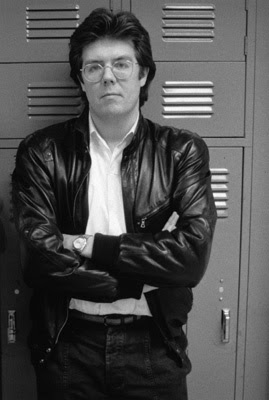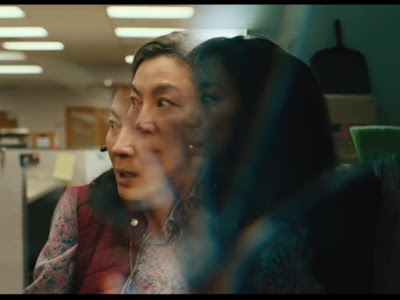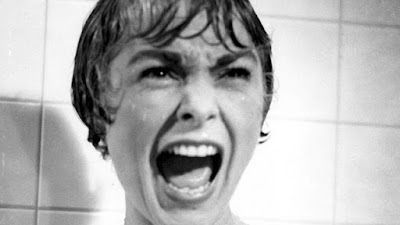WRITER'S NOTE: The following is a collection of reviews posted on my Instagram accounts @be.kerian and @film_freeq since 2020. They’ve been organized by their initial (theatrical) release dates. This profile covers one of the most influential filmmakers of the 1980s. (You can read the 1st Edition here.)
***
Mr. Mom (1983)
Back when he was known for making comedies earlier in his career, Michael Keaton headlined one of John Hughes' earliest scripts (based on the writer's own experiences as a father) by playing a family man who becomes a full-time stay-at-home dad after losing his job, while his wife (Teri Garr) takes on a new career of her own. Mishaps involving grocery shopping, laundry, the home vacuum cleaner, and an ugly plaid shirt are hysterical, and why Mr. Mom (along with Keaton's performance) remain classic 80s comedy. References to infidelity (including a soap opera fantasy sequence) and a scene in a male strip club are its major timeouts. Advice for parents: never overload the laundry or feed a baby chili.
National Lampoon’s Vacation (1983)
Released the same year as Mr. Mom, Hughes adapted his story, "Vacation '58" (first published in National Lampoon magazine), itself based on a family road trip he had as a kid. Directed by the late Harold Ramis, this 80s comedy centers around the Griswold clan as they take a cross-country trek via station wagon from Chicago, Illinois, to Walley World, California. Everything goes south at nearly every turn, leading patriarch Clark Griswold to several breaking points. This is the role that funnyman Chevy Chase will probably be most remembered for, striking a balance between a nice guy and a ticking time bomb. Nobody but him could've pulled that off so effortlessly.)
The movie itself, however, isn't as ideal as we may remember it. Sure, it has many hilarious moments and one-liners, and it may be a "family" comedy. But it's not really family-friendly, no matter how much we'd like to think it is. Various issues--er, detours (some rather dark)--range from infidelity, images of nudity and references to nude magazines, underage drinking and drug use, a climactic hostage situation, several harsh profanities, the unexpected fate of Aunt Edna and her dog, and a ghetto scene that even Ramis deeply regretted in retrospect.
TRIVIAL FACT: This was technically Hughes' first collaboration with regulars Anthony Michael Hall (as the original Rusty Griswold) and John Candy (as a theme park security guard).
Sixteen Candles (1984)
After making a name for himself as a writer for National Lampoon magazine, John Hughes made his directorial debut with this first of many comedies/dramas centered around teenage adolescence. In a breakout performance, Molly Ringwald plays Samantha Baker, whose aspirations for the perfect sixteenth birthday don't go as she had hoped. What follows is a wild night of school dances, hard partying, and a triangle of young love, leading up to one of the most iconic moments in contemporary cinema.
The film is noteworthy for its authentic portrayal of high school teenagers (including Anthony Michael Hall's geeky Farmer Ted and Michael Schoeffling's dreamy Jake Ryan), as well as genuine family dynamics. (Remember that scene between Ringwald and her screen dad Paul Dooley?) On the other hand, Sixteen Candles has also been the subject of controversy due to cultural insensitivity. Look no further than the stereotype that is Long Duck Dong. Not since Mickey Rooney's yellow-faced Mr. Yunioshi in Breakfast at Tiffany's has the Asian/Asian-American community been given such a bad wrap. (To be fair, Hughes and actor Gedde Watanabe may not have intended this, but we know better now, don't we.) Add to that some brief-but-gratuitous nudity, underage drinking, references to date rape, and Ringwald dropping an F-bomb right before the opening credits, and we have an 80s flick we need to think twice about before blowing out the candles.
Weird Science (1985)
In a 1980s-technological twist on Mary Shelley's Frankenstein, high school nerds and social outcasts Gary and Wyatt (Anthony Michael Hall and Ilan Mitchell-Smith) decide to create the girl of their wildest dreams, with disastrous and outrageous results. Weird Science is one of John Hughes' crudest comedies, and easily his most sexualized, with lead actress Kelly LeBrock as both a figure of unquestionable objectification and, surprisingly, a smarter-than-she-looks woman. An oxymoron, if ever there was one.
Bill Paxton almost steals the show as, perhaps, the worst on-screen big brother (up until, maybe, Buzz McCalister), while Robert Downey, Jr., made his feature film debut here (as one of the main bullies). And there's that catchy theme song by Danny Elfman's band Oingo Boingo. Weird Science marked the last collaboration between Hall and Hughes, and the last of the writer-director's films to be released by Universal (until 1988's The Great Outdoors) before moving to Paramount for his next five features.
TRIVIAL FACT: The house used for the climactic party sequence was later used in Richard Kelly's 2001 teenage thriller Donnie Darko.
Pretty in Pink (1986)
Pretty in Pink certainly wasn't the first movie that Hughes wrote but didn't direct. But his sensibilities are certainly evident in this coming-of-age story about economic class differences and anxieties, including a love triangle with more layers than most other related stories put together (I'm looking at you, She's All That). Personally, I didn't identify with the culture of rich kids. But the emotional struggles these characters go through are relatable and understanding (especially Molly Ringwald's Andie and Jon Cryer's Duckie). "His name is Blaine?! That's a major appliance, that's not a name!" The film's ending remains controversial, and a reason why Hughes reportedly wrote the similarly-themed although tonally-different Some Kind of Wonderful the following year.
TRIVIAL FACT: Wonderful's Eric Stoltz was originally cast (and filmed some scenes) as Marty McFly in 1985's Back to the Future before being replaced by Michael J. Fox. He did eventually work alongside actress Lea Thompson, who, after starring in the critically- and commercially-disastrous Howard the Duck in '86, had something of a career-saving role as popular girl Amanda Jones.
Ferris Bueller’s Day Off (1986)
"Bueller? . . . Bueller?" Regarded by many as the best film written and directed by John Hughes, Ferris Bueller's Day Off not only boasts a hilarious fourth-wall comedy crusade, with an irreplaceable Matthew Broderick as the iconic hooky-playing high schooler (even though nobody's really this free-spirited), Alan Ruck as best friend Cameron, and Mia Sara as girlfriend Sloane. And let's not forget Jeffrey Jones' hard-nosed principal Ed Rooney, Jennifer Grey's envious sibling Jeanie, and Ben Stein's droll economics teacher. This classic example of fantastical realism (a trademark of Hughes' filmography) also stands as something of a travelogue for the city of Chicago, Illinois. I mean, who could ever forget the art museum tour, or the parade-crashing sequence? If you haven't seen it yet but will soon ("Anyone? Anyone?"), stay through the credits!
This film and 1985's The Breakfast Club are the only John Hughes titles selected into the National Film Registry by the Library of Congress for being "historically, culturally, and aesthetically significant". [Read my full review of The Breakfast Club here.]
Planes, Trains & Automobiles (1987)*
For his first official transition into more adult-oriented films, Hughes enlisted two comedy greats. In Planes, Trains & Automobiles, Steve Martin plays Neal Page, a stuck-up marketing executive just trying to get home to see his family for Thanksgiving. But weather delays, transportation issues, and violent outbursts (including an infamous tirade at a car rental desk) turn his short trip into a three-day trek, especially when he tags along with an obnoxious-but-loveable travelling salesman. John Candy gave his best performance to date as Del Griffith, who reveals more layers and feelings than his occupation-of-choice let's on. (He sells shower curtain rings, of all things.)
The film reminds me of how cinematic Hughes was in the 1980s, in the most unconventional, down-to-earth, non-Hollywood way. He also happened to make some of the most unforgettable movies that have since become holiday staples every year. And in terms of working with the late Candy, Hughes really knew how to play to the beloved actor's strengths and bring out the qualities that made him such an admirable actor and person. Cheers, and happy Thanksgiving, everybody. [*extended review for this edition]
She’s Having a Baby (1988)
Before Planes, Hughes technically made the transition from teenage adolescence into adulthood with She's Having a Baby (released in February 1988, three months after Planes). Narrated and headlined by Kevin Bacon, the film received mixed to negative reviews from critics and did poor at the box-office, likely due to its polarizing and often-dark take on marriage, love, sex, and child-rearing.
Even though it features some clever surreal/fantasy moments (like the neighborhood song-and-dance number, complete with lawnmowers and sprinklers) and celebrity cameo appearances during the end credits, She's Having a Baby will more often than not have viewers scratching their heads, even feeling depression and wondering, "What are we to make of this?" Hughes did recuperate with subsequent (and more successful) hit movies starring John Candy.
The Great Outdoors (1988)
Canadian comedy legends Dan Ackroyd and John Candy play rival in-laws at war during summer vacation in the woods with their families. Directed by Howard Deutch (in his third consecutive and final collaboration with writer-producer John Hughes), The Great Outdoors was made during a time when both comedians were still at the top of their game, and when such "family" movies were both more sincere and crude. If there's one scene this crowdpleaser is most remembered for, it's "the Old '96er" ("That ain't the last bite"). Oh, and let's not forget the raccoons, bears, and "Land of a Thousand Dances."
Uncle Buck (1989)
Hughes directed the John Candy in another of his most unforgettable roles, as an obnoxious but endearing uncle who looks after his nieces and nephew during a family crisis. If released today, this 1989 not-really-family-friendly comedy would likely be rated PG-13, due to some surprisingly crass content. Still, this has what most comedies lack today: a genuine balance of humor, heart, and heightened laughs. (Honestly, nobody cooks pancakes or does laundry like Buck Russell!) And nobody but Candy could've pulled off such a tailor-made performance so seamlessly. At its heart, Uncle Buck is a story about an estranged relative who gets a second chance to know his family again, particularly during a complex dynamic with his niece (a brief return to teenage angst for Hughes).
Uncle Buck is also notable for introduced Hughes to a then-unknown child actor named Macaulay Culkin (who plays nephew Miles). Reportedly, Hughes was inspired to write 1990's Home Alone specifically for Culkin, based on a scene where Miles interrogates a potential babysitter through a front door mail slot.
This is one of two films from 1989 that features actresses Amy Madigan and Gaby Hoffman (the other being Field of Dreams).
National Lampoon’s Christmas Vacation (1989)
If you want full disclosure, the other installments in the Vacation film series are unnecessary cash-grabs, although they have their moments (i.e., an amusing Sound of Music parody and Eric Idle's bike rider in 1985's European Vacation, and a Hoover Dam tour and Wallace Shawn's blackjack dealer in 1997's Vegas Vacation). The 2015 reboot, starring Ed Helms as an older Rusty Griswold, was considered a major disappointment.
But if there's one installment that stands above the rest (and qualifies as the most perennial), it's 1989's Christmas Vacation. Here, the Griswold's decide to stay home and invite extended family over for the holidays. This episodic comedy (written by John Hughes, one year before Home Alone) has plenty of classic moments and lines to choose from. Trekking out in the middle of nowhere for the ultimate Christmas tree. Setting up a ridiculous amount of house lights. Getting stuck in the attic with nothing but old home movies. An obnoxious, goofy cousin pulling up in an old RV. A quirky great-aunt mistaking saying grace for the Pledge of Allegiance. ("You couldn't hear a dump truck driving through a nitroglycerin plant!")
While not as problematic as its R-rated predecessor, Christmas Vacation still comes with a few twinkle lights, specifically some peppered language issues (including the infamous scene where Clark rails about his cheapskate boss) and at least two sequences where Chase ogles a lingerie store employee. Those elements notwithstanding, this remains an uproarious holiday comedy that still makes us laugh over and over every year.



























.gif)
































